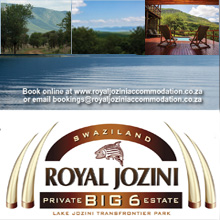SWAZILAND
The Swazis are proud and extremely friendly people. They welcome visitors with a beaming smile and take pleasure in showing off their beautiful country. As well as a number of community-run tourism initiatives, visitors are able to experience daily life in Swaziland by calling in at a local homestead, where they will be made very welcome. Alternatively, Mantenga Cultural Village is an excellent working reconstruction of a traditional homestead from around the 1850s, which gives an experience of all the complexities and nuances of traditional Swazi life; as well as a quite tremendous dancing display by a group that tours the world.
Despite being the smallest country in the Southern hemisphere, Swaziland more than makes up for its lack of size with a hugely diverse range of attractions and activities.
As one of the few remaining Executive Monarchies in Africa, culture and heritage are deeply engrained in all aspects of Swazi life, ensuring an unforgettable experience for all who visit. As well as the rich culture, the overwhelming friendliness of the people makes all visitors feel truly welcome and very safe. Add to that a stunning landscapes of mountains and valleys, forests and plains; plus wildlife reserves across the country that are home to The Big Five, and you have all that’s best about Africa in one small but perfectly formed and welcoming country.
Music and dance are embedded in traditional Swazi culture. Women sing together in the fields; men sing or utter praise poetry as they pay tribute to their chiefs or kings. There are traditional songs for every occasion: weddings, royal rituals, coming-of-age ceremonies and national festivals. Sibhaca dance is the best known of various dance forms. The dance is highly strenuous: teams of dancers step forward in turn to perform a barefoot high-kicking and stomping, while their companions behind beat drums, chant and sing. All wear traditional dress, with colourful tassels and embellishments. A typical session can last two or three hours, with different songs and styles performed.
A tiny country with a big heart and warm, friendly people aptly describes Swaziland – a country that is one of the few remaining Executive Monarchies in Africa and embraces and upholds its own unique and ancient traditions. Both the monarchy and the people of Swaziland actively maintain and preserve a remarkable cultural heritage that is probably unmatched anywhere in Africa. Visitors can get a better idea of traditional African culture here than pretty much anywhere else in the region, and what is seen, including spectacular festivals, has not simply been resuscitated for the tourist dollar but is the real deal. The famous Umhlanga (Reed Dance) and Incwala are traditional ceremonies that involve tens of thousand of Swazis, and attract visitors from all over the world. But traditional attire, ceremonies and dancing are to be found throughout the country at all times of the year.
Swaziland has a rather quiet contemporary music scene by comparison with South Africa, partly because the industry is still in its infancy and there are few recording facilities or live venues. The exception to this rule is House on Fire, an extraordinary venue that has invigorated the local music scene since it opened less than 10 years ago. Its annual Bushfire Festival, held every May attracts top acts and artists from all over the region, and audiences of up to 20,000.
On a slightly smaller scale, getting chance to watch one of Swaziland's many school choirs sing is certainly an opportunity not to be missed! Described by some as having the most beautitful voices in the world, they are truly a delight to listen to! You can see a clip of St Francis school in Mbabane singing below.
The highveld is a land of hills, waterfalls and great buttresses of ancient rock - providing the country's most dramatic and impressive landscapes. A temperate climate means some rainfall all year round and regular mists in summer, so the scenery is generally reasonably lush. While timber plantations have replaced much of the natural montane grassland habitat, Swaziland’s most impressive nature reserve, Malolotja, protects a large area of what remains.
The middleveld is generally less striking - an area of undulating bush and moist savanna lying at an average 700m above sea level. It is home to the bulk of Swaziland’s population and the tourist hub of the Ezulwini Valley. The lowveld is hot, bush country sitting as low as 21m above sea level. Although much drier than the other areas, it is home to vast, heavily irrigated sugar estates which are impressive in their own right. The remaining tracks of wild bush here harbour Swaziland's major game reserves and offer easy access to areas of genuine wilderness.
With the exception of desert and sea, every geographical feature of Africa’s terrain is found within Swaziland: magnificent mountain scenery with rivers, waterfalls and gorges; unique rock formations which are among the world’s most ancient; lush and fertile valleys, plus typical African bush. From west to east, Swaziland moves from mountainous Highveld, though Middleveld to Lowveld, and then rises again to the Lubombo mountains. Altitudes vary from 21 to 1800 m (70 to 6000 ft) – yet the country’s east and west borders are less than 200 km (125 miles) apart.
Reaching the east of the country, the Lubombos are a line of rugged volcanic hills which rise abruptly from the lowveld to some 600m. This range extends beyond Swaziland, following the Mozambique border north through the Kruger National Park and south into KwaZulu-Natal. Although from below it appears as a single line, the hills comprise a number of parallel ridges broken by deep gorges carved by the Usutu, Ngwavuma and Mbuluzi rivers. In many respects, the Lubombo region is an elevated extension of the lowveld. However, these wild and beautiful hills harbour some unusual habitats, with flora and fauna found nowhere else in the country - and the views from the top are stunning.















